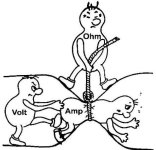James Mcquade
Member
Hi all,
I have volunteered to teach the electrical merit badge to a group of boyscouts
Saturday and i'm kind of stuck on something.
I can explain the electrical charge and electron flow or current flow (depending which way you want it) and resistance.
What I am looking for is an example they can understand and relate to.
Any examples are much appreciated.
thanks,
james
I have volunteered to teach the electrical merit badge to a group of boyscouts
Saturday and i'm kind of stuck on something.
I can explain the electrical charge and electron flow or current flow (depending which way you want it) and resistance.
What I am looking for is an example they can understand and relate to.
Any examples are much appreciated.
thanks,
james




